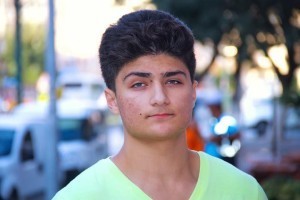敘利亞難民兒童「接管」UNICEF Twitter帳戶 講述他們充滿力量的故事
2015-09-29

© UNICEF/NYHQ2013-1390/Noorani
在2013年,一個家庭走過約旦的雅達利難民營。
敘利亞的衝突已經踏入第5年,影響上百萬兒童的生活。在敘利亞,兒童生活在殺戮和受傷的惶恐中。200萬兒童沒有上學,5萬個教師逃離家園。衞生服務也崩潰了。土耳其、黎巴嫩和約旦現正合共接收了400萬個敘利亞的難民。最近,數以千計兒童展開極度危險的旅程,前往歐洲希望尋找更好的生活,類似報導佔據不頭條。
不論是關於他/她的旅程、現實情况、夢想又或者是重建敘利亞的希望,每名敘利亞的小童都有他們的故事,他們很希望可以將這些故事告訴大家。
在今晚(9月30日晚),聯合國兒童基金會(UNICEF)會將官方的Twitter頻道,交予四名敘利亞的兒童。他們分別是14至17歲,現在住在土耳其、約旦和奧地利的Youssef、Omaymah、Anhal、Hanin 。他們將會用一個小時分享他們的故事,亦希望呼籲Twitter的用戶能關注敘利亞衝突對上百萬兒童的生命的影響。
今次UNICEF twitter專頁「接管」活動,與聯合國一場關於難民與移民流向的討論於同日舉行──我們希望有力量的人可聽到這些兒童的聲音,作出最後的改變。
你可以怎樣參與呢?
今晚香港時間8時至凌晨2時,每個參與的兒童會被給予UNICEF Twitter專頁的控制權,你可以透過follow UNICEF的官方twitter專頁,或follow #youthtakeover及#refugeecrisis等hashtags,看到他們自白(你毋須擁有twitter帳戶,也可follow上述的hashtags)。
我們邀請你retweet他們的說話,令他們的聲音能走得更遠,這些可提升對兒童難民的認識。你也可以問他們關於旅程,和他們面對的挑戰等的問題。
最後,我們將當天的情況歸納在Storify上,即使您在當天錯過了,亦可在Storify上重溫。
誰在9月30日「接管」UNICEF Twitter帳戶?
 |
在土耳其生活的Youssef (17歲) Youssef跟他的母親和兩位兄弟,與兩年前離開敘利亞。他們乘搭巴士從敘利亞阿勒坡到土耳其,路上一直害怕會被攻擊。甫抵達土耳其,Youssef馬上與他的弟弟和親戚尋找工作,並成功受聘於一家建築公司。Youssef以前每天工作11小時,現在已入學。雖然讀書對他來說十分重要,但他在放學以後仍然繼續工作直至深夜10時。在敘利亞時,他一直夢想着要創立一家科技公司,但現在他一心要重建家園。他認為,來自敘利亞的兒童都樂於工作和學習,並需要這些機會。 |
 |
|
|
在約旦雅達利難民營 (Za’ Atari camp)生活的Anhal (16歲)
Anhal在2012年12月與媽媽與兩個姊妹從德拉到達雅達利難民營。他有5個兄弟和5個姊妹;其中一個姊妹與家人尚在敘利亞,而另一位兄弟則與他的家庭住在阿拉伯。在前往約旦的路上,他們乘搭出租小巴,直至邊境後5公里,之後他們便要開始走路。在到達難民營時,他又喜又悲:喜的是他們終於獲得安全,悲的是他真正離開了他的家。在難民營,他失學一年,幸好他的父親讓他註冊學校,而Anhal現在就讀於十一年級。他一直在班上名列前茅。Anhal最喜歡數學、科學、生物與地理。他的夢想是成為像兄弟一樣的地理學家。在閒餘時間,他喜歡學習和踢足球——他是足球隊伍皇家馬德里的忠實粉絲。 |
 |
|
在奧地利生活的Hanin (16歲)
被炸彈摧毀家園後,當時13歲的Hanin和媽媽及姊姊立即離開敘利亞。她的兄弟早已離開。她們搭巴士到伊斯坦堡,並在那裏居住了兩年。在前往歐洲的途中,Hanin和家人失散了。在陌生人的幫助下,Hanin獨自前往匈牙利,最終進入奧地利地區。在孤身生活一年以後,她在數個月後與家人團聚。像很多人一樣,Hanin十分掛念敘利亞,並希望將來能成為一名牙醫或攝影師。 |
 |
| 立即捐款,幫助災難中的兒童 |









